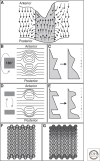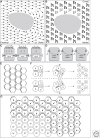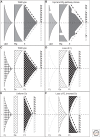Gradients and the specification of planar polarity in the insect cuticle
- PMID: 20066114
- PMCID: PMC2773641
- DOI: 10.1101/cshperspect.a000489
Gradients and the specification of planar polarity in the insect cuticle
Abstract
In addition to specifying cell fate, there is a wealth of evidence that molecular gradients are also primarily responsible for specifying cell polarity, particularly in the plane of epithelial sheets ("planar polarity"). The first compelling evidence of a role for gradients in specifying planar polarity came from transplantation experiments in the insect cuticle. More recent molecular genetic analyses in the fruit fly Drosophila have begun to give insights into the molecular nature of the gradients involved, and how they are interpreted at the cellular level.
Figures





Similar articles
-
Cell interactions and planar polarity in the abdominal epidermis of Drosophila.Development. 2004 Oct;131(19):4651-64. doi: 10.1242/dev.01351. Epub 2004 Aug 25. Development. 2004. PMID: 15329345
-
Asymmetric localization of frizzled and the establishment of cell polarity in the Drosophila wing.Mol Cell. 2001 Feb;7(2):367-75. doi: 10.1016/s1097-2765(01)00184-8. Mol Cell. 2001. PMID: 11239465
-
Planar cell polarity in the Drosophila eye is directed by graded Four-jointed and Dachsous expression.Development. 2004 Dec;131(24):6175-84. doi: 10.1242/dev.01550. Epub 2004 Nov 17. Development. 2004. PMID: 15548581
-
Frizzled signaling and the developmental control of cell polarity.Trends Genet. 1998 Nov;14(11):452-8. doi: 10.1016/s0168-9525(98)01584-4. Trends Genet. 1998. PMID: 9825673 Review.
-
The frizzled/stan pathway and planar cell polarity in the Drosophila wing.Curr Top Dev Biol. 2012;101:1-31. doi: 10.1016/B978-0-12-394592-1.00001-6. Curr Top Dev Biol. 2012. PMID: 23140623 Free PMC article. Review.
Cited by
-
Planar cell polarity: global inputs establishing cellular asymmetry.Curr Opin Cell Biol. 2017 Feb;44:110-116. doi: 10.1016/j.ceb.2016.08.002. Epub 2016 Aug 26. Curr Opin Cell Biol. 2017. PMID: 27576155 Free PMC article. Review.
-
Wnt/PCP proteins regulate stereotyped axon branch extension in Drosophila.Development. 2012 Jan;139(1):165-77. doi: 10.1242/dev.068668. Development. 2012. PMID: 22147954 Free PMC article.
-
Planar cell polarity signaling in the Drosophila eye.Curr Top Dev Biol. 2010;93:189-227. doi: 10.1016/B978-0-12-385044-7.00007-2. Curr Top Dev Biol. 2010. PMID: 20959167 Free PMC article. Review.
-
A theoretical framework for planar polarity establishment through interpretation of graded cues by molecular bridges.Development. 2019 Feb 1;146(3):dev168955. doi: 10.1242/dev.168955. Development. 2019. PMID: 30709912 Free PMC article. Review.
-
An extended steepness model for leg-size determination based on Dachsous/Fat trans-dimer system.Sci Rep. 2014 Mar 11;4:4335. doi: 10.1038/srep04335. Sci Rep. 2014. PMID: 24613915 Free PMC article.
References
-
- Adler PN, Krasnow RE, Liu J 1997. Tissue polarity points from cells that have higher Frizzled levels towards cells that have lower Frizzled levels. Curr Biol 7:940–949 - PubMed
-
- Adler P, Charlton J, Liu J 1998. Mutations in the cadherin superfamily member gene dachsous cause a tissue polarity phenotype by altering frizzled signaling. Development 125:959–968 - PubMed
-
- Amonlirdviman K, Khare NA, Tree DRP, Chen W-S, Axelrod JD, Tomlin CJ 2005. Mathematical modeling of planar cell polarity to understand domineering non-autonomy. Science 307:423–426 - PubMed
Publication types
MeSH terms
Substances
Grants and funding
LinkOut - more resources
Full Text Sources
Molecular Biology Databases
